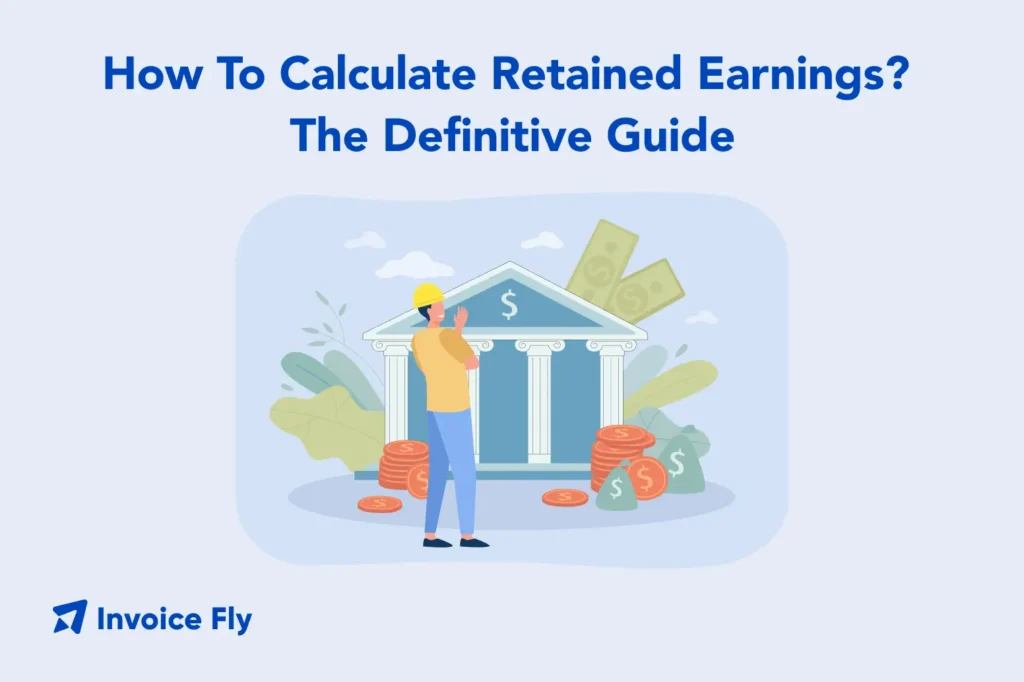How To Calculate Retained Earnings? The Definitive Guide

Table of Contents
- What are Retained Earnings?
- What is the Retained Earnings Formula?
- Beginning of Period Retained Earnings
- How Net Income Impacts Retained Earnings
- How Dividends Impact Retained Earnings
- End of Period Retained Earnings
- Example Calculation
- Video Explanation of Retained Earnings
- Applications in Financial Modeling
- Additional Resources
- The Financial Modeling Certification
- Managing Your Business Finances
- Final Thoughts
- FAQs about Retained Earnings
How do you calculate retained earnings? Here’s the simple formula: Beginning Retained Earnings + Net Income – Dividends = Ending Retained Earnings.
This easy calculation shows how much profit your business has saved up over time.
If you own a business or work with money, you need to know how to calculate retained earnings. This guide will show you everything: formulas, examples, and helpful tips.

What are Retained Earnings?
Retained earnings are the profits your company made but didn’t give to shareholders as dividends. Think of it as money your business earned and decided to keep for future growth, paying off debt, or other business needs.
These earnings pile up on your balance sheet over time. They create a money cushion that helps your business during hard times or when you want to invest in new opportunities. For small businesses, retained earnings often provide the main source of money for growth without taking on debt.
When you prepare your ending retained earnings calculation, you’re measuring how much profit your company has saved over its lifetime.
The Purpose of Retained Earnings
Retained earnings help businesses in several important ways:
- Growth and Expansion
Fund new projects, equipment, or operations—without taking on debt or giving up ownership. - Financial Safety
Create a buffer for tough economic periods or surprise expenses. - Debt Reduction
Lower your interest costs by paying down existing debt.
Many freelancers and small business owners find that building retained earnings helps them manage cash flow during slow periods. Unlike big corporations, small businesses often rely more on retained earnings for flexibility.

What is the Retained Earnings Formula?
Here’s the formula:
Retained Earnings = Beginning Retained Earnings + Net Income – Dividends
| Component | Description | Where to Find It |
| Beginning Retained Earnings | Balance from the previous period | Previous period’s balance sheet |
| Net Income | Profit after all expenses and taxes | Bottom line of the income statement |
| Dividends | Profit paid out to shareholders | Cash flow or earnings statement |
| Ending Retained Earnings | Final retained earnings for the current period | Current period’s balance sheet |
Breakdown of Retained Earnings Formula and Where to Find Each Component
This formula appears on your balance sheet and connects directly to your income statement of operations through net income. Understanding this relationship is important for accurate financial statements and effective financial projections.
When using Excel or accounting software like Invoice Fly, this is often auto-calculated. Still, understanding the logic helps catch errors and guide smarter business decisions.
Beginning of Period Retained Earnings
If your business is brand new, your beginning balance is zero. Otherwise, it carries over from the last period’s ending balance.
In QuickBooks, this is automated. But double-checking accuracy is wise, especially after changes to past statements.
Accumulated Deficit? That’s Okay
If your starting balance is negative, that’s called an accumulated deficit. This means you’ve lost more than you’ve earned. It’s common in new or struggling businesses.
Trial Balance Check
Before calculating anything, make sure your trial balance is accurate. Your ledger balance should match your trial balance before moving forward with financial statements.
How Net Income Impacts Retained Earnings
Net income is the amount left after expenses and taxes.
- Profit = retained earnings go up
- Loss = retained earnings go down
Your income statement shows how you got to net income, using:
- Revenue
- Cost of Goods Sold
- Operating expenses
- Other income or losses
Understanding the Income Statement Connection Every line item on your income statement ultimately affects your retained earnings calculation. Understanding gross profit vs. net profit helps you see how different business decisions impact your retained earnings.
Real-world example: Sarah owns a marketing agency. Last year, she made $150,000 in net income and paid no dividends. Her entire profit added to retained earnings—helping her buy new equipment and hire more staff.
For freelancers and consultants, understanding how different income streams affect net income helps with tax planning and cash flow management. Every dollar of net income adds to your retained earnings, building long-term financial stability.
How Dividends Impact Retained Earnings
Dividends are payments made to shareholders from company profits. Dividends reduce retained earnings dollar for dollar. This is why the formula subtracts dividends from net income.
Key tips:
- Not every business pays dividends—many reinvest everything
- Different business types (LLC, S-corps, partnerships) have different payout rules
- Always check your cash flow—retained earnings ≠ cash in the bank
For businesses tracking bad debt calculation, make sure dividend payments don’t hurt your ability to handle potential write-offs.
Cash Flow Considerations Need to plan for dividend payouts? Be sure your cash flow statement backs up your ability to distribute profit. If you’re also tracking bad debt, ensure dividends don’t leave you short.
End of Period Retained Earnings
Your ending retained earnings is the amount of profit your company has saved over its lifetime.
It appears in the equity section of your balance sheet and represents ownership value that belongs to shareholders.
The ending retained earnings balance must balance with other equity accounts on your sheet. Understanding your ledger balance helps make sure that your retained earnings calculation aligns with your overall financial records. Regular checking prevents errors that could affect your financial statements.
Balance Sheet Integration
Your ending retained earnings must balance with other equity accounts on your balance sheet:
- Contributed capital
- Treasury stock
- Other comprehensive income
Reminder: Total equity = Assets – Liabilities, and your retained earnings must help that equation stay balanced.
Example Calculation
Let’s walk through a real example with ABC Manufacturing:
Starting Numbers:
- Beginning Retained Earnings (January 1): $75,000
- Net Income for the Year: $45,000
- Dividends Paid: $10,000
Calculation: $75,000 + $45,000 – $10,000 = $110,000
Result: Ending Retained Earnings (December 31): $110,000
This means ABC Manufacturing increased their retained earnings by $35,000 during the year ($45,000 net income minus $10,000 in dividends).
How to Set It Up in Excel
- Create columns: Beginning Balance | Net Income | Dividends | Ending Balance
- Use formulas to calculate automatically
- Track changes monthly or quarterly
Video Explanation of Retained Earnings
While written guides provide detailed explanations, many business owners find video tutorials helpful for understanding retained earnings calculations.
- CFI explanation of Financial Analysis Fundamentals
- Complete a Balance Sheet by solving for Retained Earnings
Applications in Financial Modeling
Retained earnings play a big role in financial modeling and planning. When creating financial projections, retained earnings help predict future cash flow and funding needs.
Financial analysts use retained earnings trends to assess:
- Company growth trajectory
- Dividend sustainability
- Financial health and stability
- Management’s capital allocation strategy
According to the Corporate Finance Institute, companies with consistent retained earnings growth often demonstrate better long-term financial performance and stability.
Additional Resources
Need tools for better financial tracking?
- Invoice Maker – Professional, fast invoicing
- Free Invoice Templates
- Break-even Point Calculator
Want to learn about how to create financial projections? It’s the next step after calculating retained earnings.
The Financial Modeling Certification
Analyst Certification FMVA® Program
The Financial Modeling & Valuation Analyst (FMVA®) certification covers advanced topics in financial analysis, including:
- Retained earnings calculations
- Financial statement analysis
- Valuation techniques
This program helps professionals:
- Master Excel-based financial modeling
- Understand complex financial statement relationships
- Develop skills in financial forecasting and planning
- Build credibility with employers and clients
The certification includes practical exercises using real financial data, helping participants apply retained earnings concepts in professional settings.

Managing Your Business Finances
Calculating retained earnings is just one piece of effective financial management. Small business owners need reliable tools to track income, expenses, and maintain professional relationships with clients.
Creating professional invoices helps ensure timely payments that contribute to positive cash flow and, ultimately, higher retained earnings. When your invoicing process is efficient and professional, you’re more likely to maintain strong client relationships and steady revenue streams.
Earnings Statement Tracking
Beyond basic retained earnings calculations, businesses should track their earnings statement trends over time. This includes:
- Monitoring revenue growth
- Expense control
- Profit margins
These metrics directly impact your retained earnings and overall financial health.
Sheet Organization
Whether using Excel or accounting software, organizing your financial data in clear, logical sheets helps prevent errors and improves decision-making:
- Create separate sheets for different periods
- Maintain consistent formatting across all calculations
- Use clear, descriptive headers

Final Thoughts
With the right formula and understanding of your financial statements, you can easily track your retained earnings. Remember that this important metric reflects your business’s ability to generate and keep profit over time.
Whether you’re preparing financial statements, planning for growth, or seeking investment, accurate retained earnings calculations provide valuable insights into your business’s financial health and future potential.
Key takeaways:
- Monitor regularly to guide smart decisions
- Reinvest wisely and stay cash-aware
- Build retained earnings for long-term stability
FAQs about Retained Earnings
That’s called an accumulated deficit. Your business has lost more than it made. Totally normal for new companies.
Not directly. The profits were already taxed as business income. Dividends, however, may trigger personal tax.
Quarterly or annually. Monthly reviews are helpful for cash flow planning.
Not automatically. You may have spent that profit on equipment or payroll. Cash flow ≠ retained earnings.
